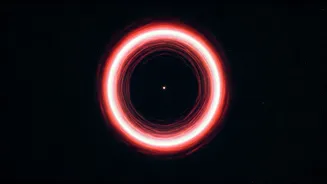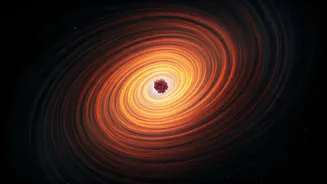Dark Matter's Enigma
Dark matter, a mysterious substance composing a considerable part of the universe's mass, is not directly visible, making its study extremely challenging.
Its existence is inferred from its gravitational effects on visible matter, such as galaxies and stars. Current models predict that dark matter should form clumps of varying sizes throughout the universe. Detecting these clumps, especially smaller ones, is vital for confirming these theories and understanding how dark matter interacts with the cosmos. The recent discovery involved the use of gravitational lensing, a phenomenon where light from distant objects is bent and magnified by the gravity of massive objects in the foreground, acting like a cosmic magnifying glass.
Gravitational Lensing's Role
Gravitational lensing played a crucial role in the detection of this tiny dark matter clump. This technique exploits the fact that the gravity of massive objects warps spacetime, causing light to bend around them. When light from a distant galaxy passes by a massive object like a galaxy cluster, the light is bent and magnified, allowing astronomers to observe the object in greater detail. This bending of light can also reveal the presence of dark matter, which contributes to the gravitational field. By studying the distortions in the light from background galaxies, scientists can map the distribution of dark matter and identify small clumps, as was the case with this new finding. This method enables astronomers to peer into the distant universe with an enhanced view.
The Discovery Explained
The astronomers who made this discovery analyzed data from multiple telescopes, using gravitational lensing to magnify the light from a distant galaxy. They observed subtle distortions in the light, indicating the presence of a small, dense object, which they identified as a clump of dark matter. This clump is remarkably compact, representing the smallest such structure detected so far. Its size and mass provide crucial information about how dark matter is distributed throughout the universe. The discovery, located 10 billion light-years away, underscores the power of gravitational lensing to reveal hidden cosmic structures. This helps to better understand the nature of dark matter itself.
Significance of the Find
This detection is significant for several reasons. First, it confirms the existence of smaller dark matter structures than previously observed, which aligns with theoretical predictions. The study of these small clumps can help refine models of dark matter distribution. Second, the discovery offers insights into the particle nature of dark matter. The characteristics of this clump, such as its density and distribution, can provide clues about the properties of dark matter particles. Further research on these structures may help differentiate between various dark matter candidates, such as weakly interacting massive particles (WIMPs) or axions. The findings provide crucial constraints on models of dark matter and could lead to a more complete understanding of the universe.
Future Research Directions
Future research on this topic is expected to involve both observational and theoretical efforts. Astronomers plan to use even more advanced telescopes, like the James Webb Space Telescope, to study these dark matter clumps in greater detail. The advanced instruments will provide higher-resolution images and allow for a more precise analysis of the lensing effects. Theoretical astrophysicists will continue to refine their models of dark matter structure formation, comparing predictions to observational data. Additionally, scientists will investigate the relationship between these small dark matter clumps and the formation of early galaxies. The combined efforts should pave the way for a more comprehensive understanding of the role dark matter plays in shaping the cosmos. The future promises even more surprising discoveries.








